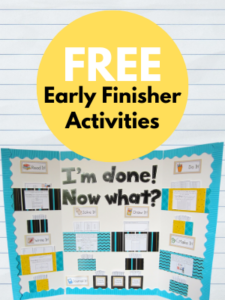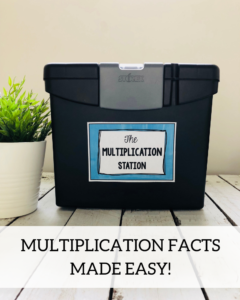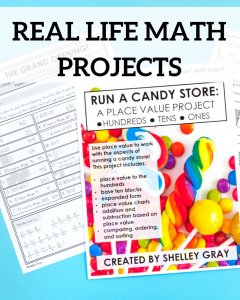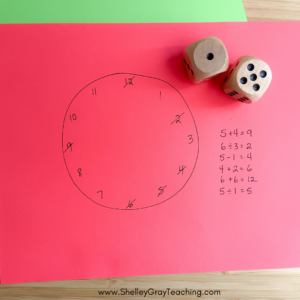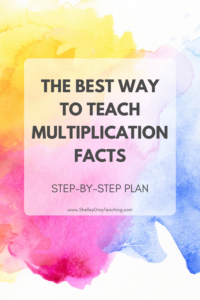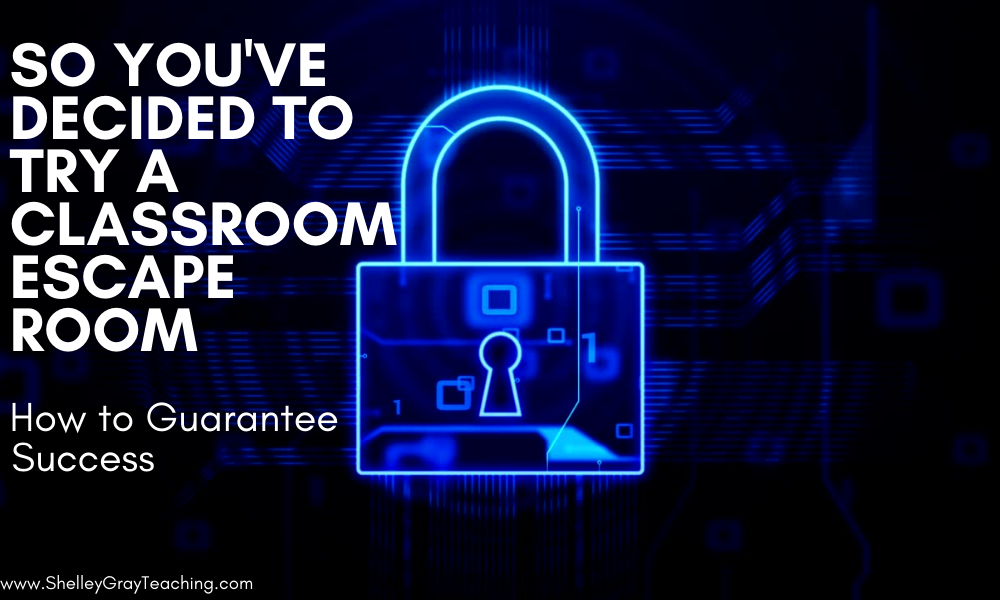
So you’ve decided to try an escape room in your classroom! The thought of implementing an escape room can be intimidating, but if done correctly, it can be the highlight of your students’ year in Math class. If you’ve never done an escape room in your classroom before, here are some essential tips to remember.
But first…
What is a Classroom Escape Room and How Does It Work?
A classroom escape room is a series of obstacles or challenges that students complete as a team. They involve review of a specific concept but in an incredibly engaging way. The goal of the escape room is to solve all the obstacles along with your team, as quickly as possible. Escape rooms are high-energy and high-motivation and your students will review a HUGE amount of information in the span of about one hour (without even realizing it).
Here is an example of the materials from the Lost In The Woods Escape Room. In this one, the teacher reads the back story first. Students are “lost in the woods” and must overcome the obstacles in order to find their way back home. The obstacles involve building a fire, finding shelter, finding food, crossing an old bridge, and more.

Each obstacle contains materials such as puzzles, codes, and other activities. In this escape room, there is a multiplication focus, so all the obstacles involve multiplication.

Once students work as a team to complete each task and overcome all six obstacles, they have completed the escape room and made it home!
Escape Rooms have the potential to be a huge highlight for your students. You might see students jumping up and down in excitement. You might see students who are typically reluctant getting excited about math. You almost certainly will have your students begging you to do another one.
But there are some tips that will increase your chances of success with an escape room. Here they are!
Solve the Obstacles Yourself First
As you prepare the obstacles, be sure that you solve each one yourself first. Your understanding of each obstacle should be excellent, as you will be busy helping groups during the actual escape room. The more comfortable you are with each obstacle, the more you can help your class during the actual event (rather than trying to figure everything out at that time). Some of them require some deep thinking, so the more prepared you are, the better.
Choose Too Easy Rather Than Too Difficult
If you are trying to choose between two escape rooms, always choose the one that you KNOW your students can be successful at. Even if the content is review for your students, they will be highly engaged with the challenge of the obstacles and puzzles. Remember – your goal during an escape room is student engagement, first and foremost. This is not a time to be struggling with content or to be learning new things.
Pre-Teach/Review
An escape room activity can be a busy time for the teacher, because the groups may have a lot of questions when they get the new task. You can help alleviate this by taking a few minutes before you begin to pre-teach/review any concepts or instructions you think they might struggle with.
Have Students Choose Roles – Reader, Writer, Runner
I like to have three specific roles for team members – reader, writer, and runner. If you have more than three students in a group, some can share a role. The reader is the person who will read the description and task on each new envelope they get. The writer is the person who will write the answers that the team comes up with. The runner is the person who takes the envelope back to the teacher and gets a new one.
Be Excited!
Always remember – your excitement is contagious! If you show excitement during an escape room, your students will naturally feed off of it. I cannot stress this enough! Make a big deal out of it when your students come to get a new envelope! Make a big deal out of the fact that they have almost completed a challenge! Encourage and motivate the groups as you circulate! This is one of the big keys to success.
Keep the Struggle Productive
There’s a fine line between productive struggle and unproductive struggle. A team that is showing productive struggle may be struggling to figure something out, but they are highly engaged.
They KNOW that solving the obstacle is possible and are working hard to do it.
No intervention is necessary.
A team that is showing unproductive struggle has crossed into a place where you don’t want them. Maybe they feel overwhelmed. Maybe they’re feeling like the obstacle is too difficult. Maybe they’re feeling like they are way behind the other groups. They may have stopped working on the challenge because it doesn’t feel possible to tackle.
This is where you must intervene.
How can you get this group back on track to a place of productive struggle?
Help them!
Show them how to do an obstacle, and give them some tips that make them feel like you’re sharing a big secret with them! (Ssshhhh! Don’t tell the other teams!) – it’s not going to hurt anything and it feels like progress is being made once more. This feeling of making progress is powerful; now they are ready to tackle the next problem on their own and are back to a place of productive struggle.
Your goal is to keep students in productive struggle. I promise, everyone will have more fun.
Provide Supports if Necessary
Sometimes you might want to do an escape room where you know the content might be a bit too difficult. This is where you could provide some supports. For example, if you are doing the Lost in the Woods Multiplication Escape Room with a group of Grade 3’s who don’t know all their multiplication facts yet, you could provide a multiplication chart as a support. If you are doing the Stranded Fraction Escape Room with a group who you think may struggle with the content, you could provide some fraction strips to help. Your goal is to ensure that your students love this activity. You want them jumping for joy because they are so excited! If supports are necessary for this to happen, then be sure to use them.
Ready to Try An Escape Room?
If you are ready to tackle an escape room in your classroom, view them all HERE. You’ll find escape rooms for all kinds of concepts including addition/subtraction, fractions, multiplication, and more! Each escape room centers around a theme – Lost in the Desert, Egyptian Escape, Stranded on an Island, Finding Rudolph, and much more.
I hope these tips help you feel more confident as you try your first classroom escape room. You will learn so much from doing your first one – what went well, how you’ll change it for next time, and what your students need to be successful. If you try one, be sure to let me know how it went in the comments below. I always love to hear from you!

